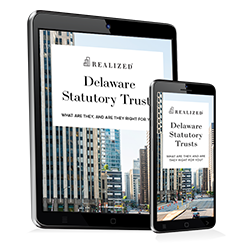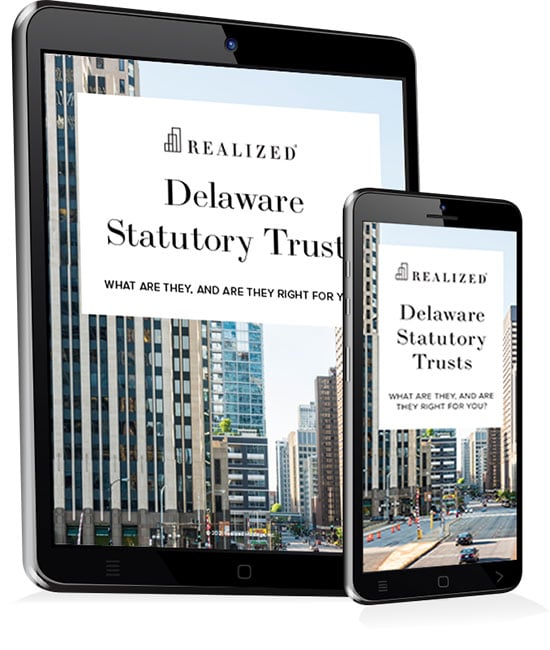
Entering a Delaware Statutory Trust (DST) is a strategic investment approach that allows individuals to pursue passive income as well as diversification. Paired with a 1031 exchange, investors may also defer certain taxes, which can support longer-term wealth preservation. However, DSTs have a finite life cycle. When the DST liquidates its assets five to 10 years after its initial establishment, investors will need to decide how to handle the proceeds. What are the next steps, then?
Below, Realized 1031 has shared an article discussing DST rollovers and the reinvestment strategies that may be available at this important juncture
What Happens Once a DST Ends?
A typical DST lasts from five to seven years, with some being as long as 10 or 15 years. During these holding periods, investors typically receive income generated by the underlying properties. Once the contract is over, the DST sponsor will sell the underlying properties. This stage is called the liquidity event. The DST is effectively dissolved, and the proceeds from the trust will be distributed to investors one final time.
The liquidity event may trigger tax liability if you don’t act quickly, especially if you entered the DST through a 1031 exchange. Any capital gains or depreciation recapture that you previously deferred will suddenly become due, and as such, timely action is essential. Failure to plan for the liquidity event could result in a significant tax obligation, potentially offsetting years of deferred tax benefits.
Continuing a 1031 Exchange to Another DST
The common DST rollover strategy is to continue the 1031 exchange cycle and use the proceeds to enter another DST. This approach may allow the investor to continue deferring capital gains taxes while maintaining a passive investment structure. While the IRS does require the assets to be real property in a like-kind exchange, DST shares are structured based on Revenue Ruling 2004-86, allowing them to qualify as both replacement and relinquished property.
You will still need to follow the standard 1031 exchange process when entering a new DST. In this case, the liquidity event serves as the closing date, which triggers the 180-day deadline. During the first 45 days, you’ll need to identify DST offerings that have similar or greater value than the previous one. DSTs are, thankfully, pre-structured options, which may simplify identification compared to direct real estate acquisitions.
In addition to the potential for continued tax deferral and streamlined identification, DSTs may offer the following features:.
- Passive Income: DSTs involve no active property management, which may appeal to investors seeking reduced day-to-day involvement.
- Diversification: Investors may gain exposure to different asset classes, markets, or sectors through new DSTs.
- Familiarity: Reinvesting into a structure you’ve previously used can reduce the learning curve and provide a level of operational consistency.
Risks to Consider When Exchanging Into Another DST
While exchanging into another DST can support tax deferral and portfolio diversification, it’s important to understand the associated risks. Key considerations include:
- Illiquidity: DSTs are long-term investments with limited options for early exit. Investors should be prepared to hold for the full duration of the trust’s term.
- Lack of Control: DST investors do not have authority over property-level decisions, including leasing, financing, or sale timing.
- Market and Tenant Risk: Income and value depend on the performance of the underlying real estate and tenants, which can be affected by market cycles or tenant instability.
Additional risks may apply depending on the specific DST structure, sponsor, and asset type. Investors should review offering documents carefully and consult qualified tax and financial professionals before reinvesting.
Alternative Reinvestment Strategies That May Maintain Tax Deferral
If you no longer want to reinvest in a DST, there are other options available.
Direct Acquisition
If the liquidated funds are high enough, you can use the proceeds to directly acquire a new replacement property. Compared to DSTs, this strategy gives you more control over the asset and potentially higher returns. More management responsibility comes with direct acquisitions, so set your expectations before entering this arrangement.
Tenancy-in-Common (TIC)
Another method is to enter a TIC with the proceeds of the DST sale. TIC structures allow multiple investors to co-own a property, each holding an undivided fractional interest. These interests may qualify for 1031 exchange treatment under IRS Revenue Procedure 2002-22. Keep in mind, though, that TICs may involve stricter coordination requirements and unanimous decision-making.
When considering these two options, make sure to take a closer look at the risks and rewards you may encounter. It’s also important to choose a reinvestment strategy that aligns with your liquidity needs and desired involvement in property management.
Proper timing is also important when rolling over DST proceeds to preserve tax deferral. One of the most common mistakes is failing to reinvest the entire amount you received from the liquidity event. This leftover cash results in a partial tax liability known as “boot,” which includes any cash received or a reduction in debt that is not offset by new debt or equity. To fully defer gains, the entire net proceeds must generally be reinvested into like-kind property of equal or greater value, with any associated debt appropriately replaced or offset.
What If You Don’t Want To Continue the 1031 Exchange Cycle?
There may come a point when you no longer want to continue exchanging properties. In such cases, you simply accept the proceeds from the liquidity event and use them elsewhere. However, this decision generally results in a taxable event. The IRS will treat the transaction as a sale, and capital gains taxes—along with any depreciation recapture from prior 1031 exchanges—may be due in the year of the sale. This tax liability can be substantial, particularly if the relinquished property has significantly appreciated over time.
There are strategies that may help manage or mitigate the tax impact. One option some investors explore is the use of a charitable remainder trust (CRT). A CRT is an irrevocable trust that can provide an income stream to the donor (and possibly other beneficiaries) for a set term or life, with the remainder ultimately passing to a qualified charity. When structured properly, a CRT can allow for the sale of appreciated assets without immediate capital gains recognition, potentially reducing the upfront tax burden and creating a vehicle for philanthropic giving and income distribution.
As with any complex strategy, CRTs involve specific legal, tax, and administrative requirements, and may not be suitable for all investors. Professional tax and legal guidance is strongly recommended before pursuing this path.
Wrapping Up: The Basics of Delaware Statutory Trust Rollovers
Once the holding period of a DST is over, investors may want to rollover the proceeds and continue the 1031 exchange cycle for tax deferral. There are various approaches you can try, such as entering a new DST, acquiring a new property directly, or joining a TIC. Whichever rollover strategy you want, timing and planning are essential. That way, you can maintain your tax-deferred status and avoid triggering tax liability.
The tax and estate planning information offered by the advisor is general in nature. It is provided for informational purposes only and should not be construed as legal or tax advice. Always consult an attorney or tax professional regarding your specific legal or tax situation.
Article written by: Story Amplify. Story Amplify is a marketing agency that offers services such as copywriting across industries, including financial services, real estate investment services, and miscellaneous small businesses.
Sources:
https://www.irs.gov/pub/irs-drop/rp-02-22.pdf



